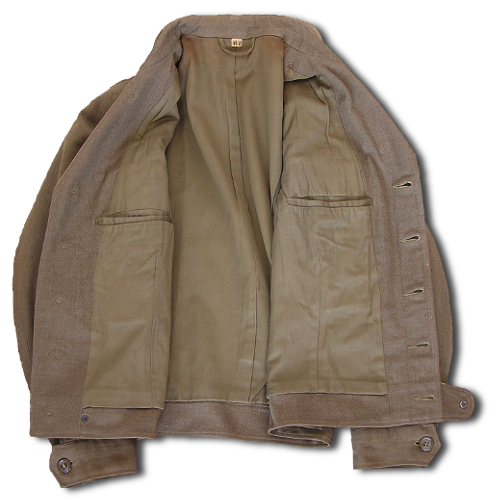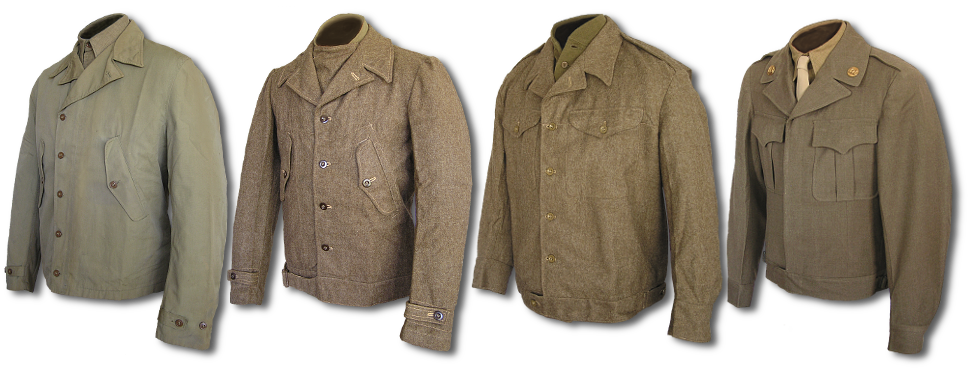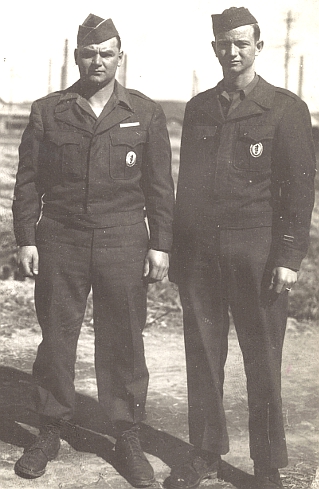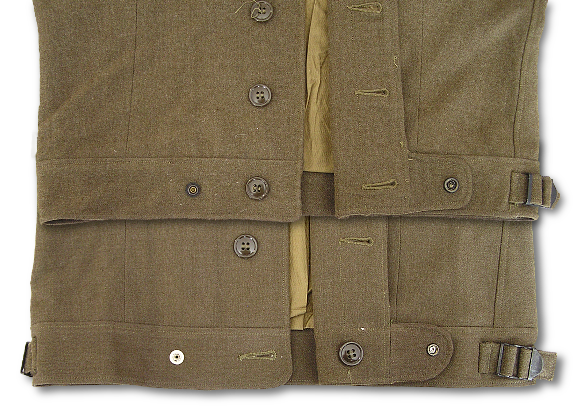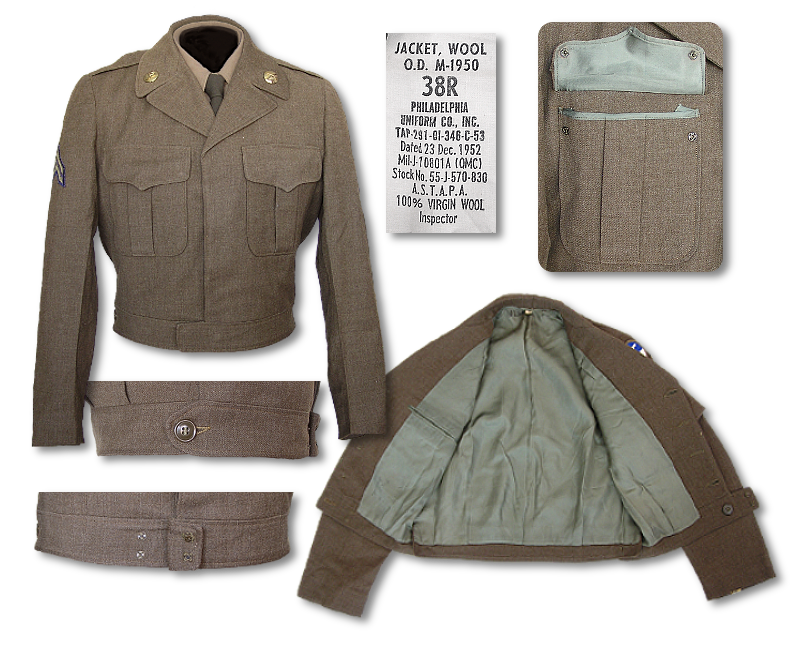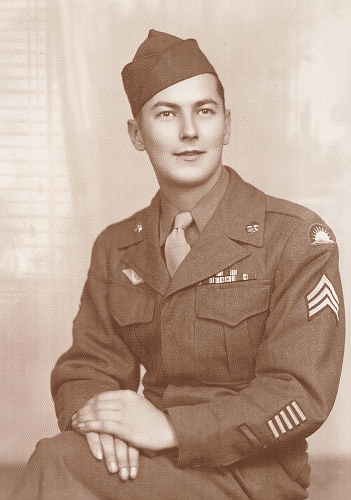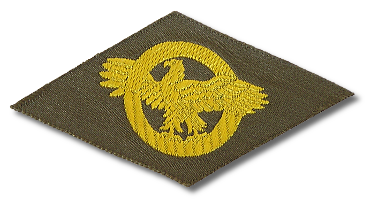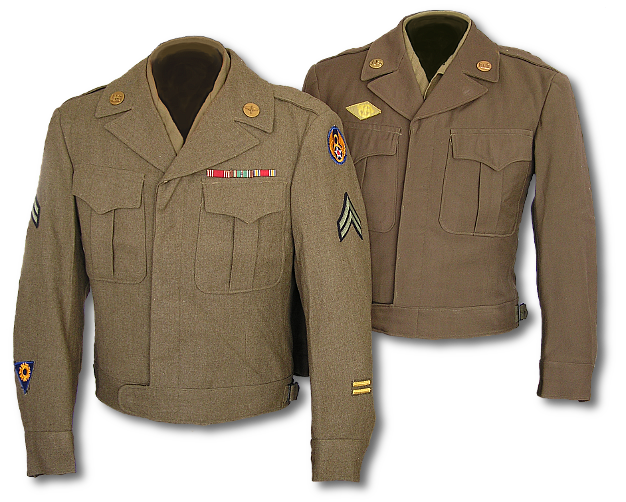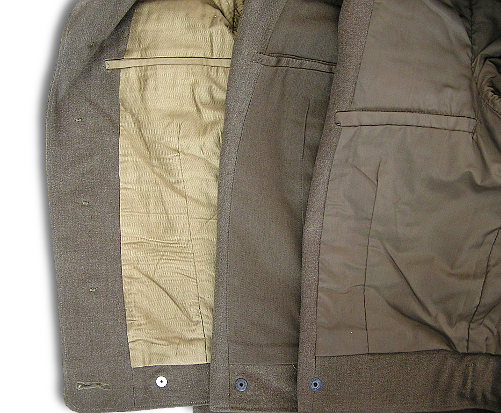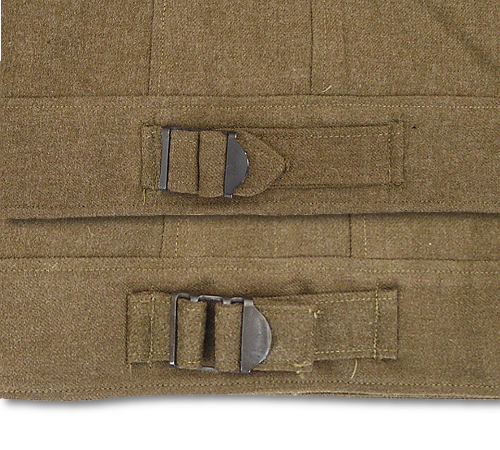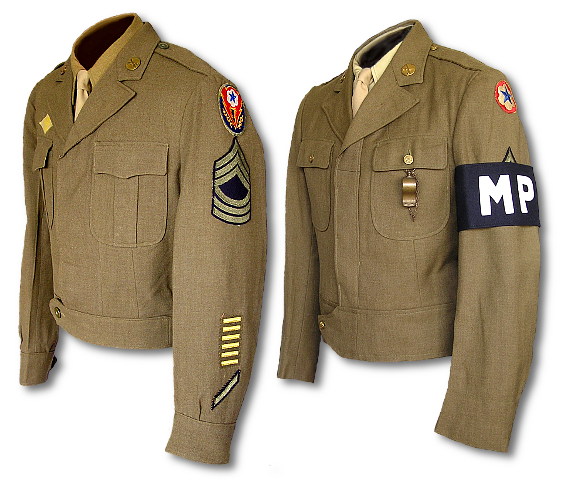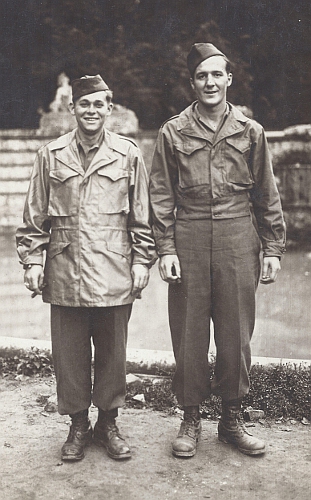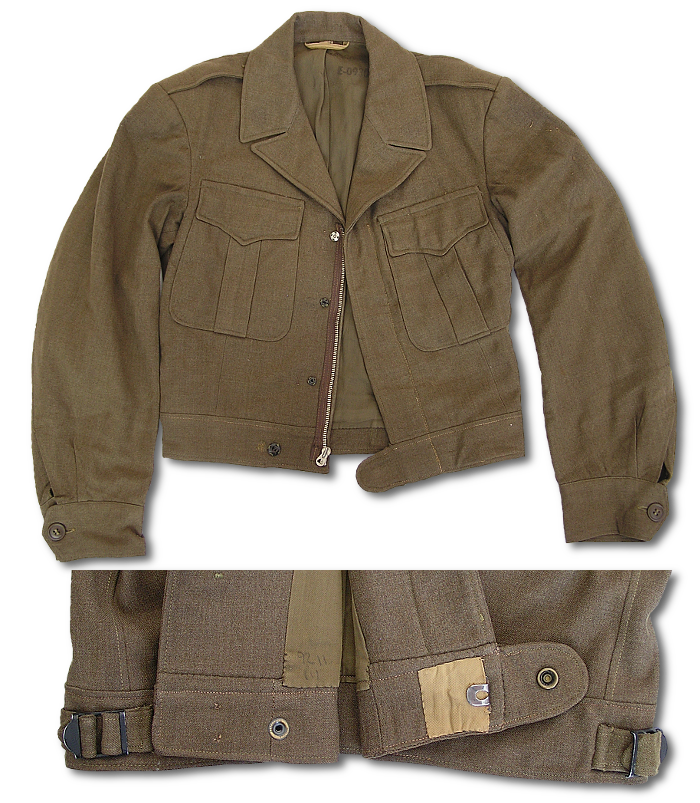U.S. Army Men's Jackets
Olive Drab Wool Field Jacket
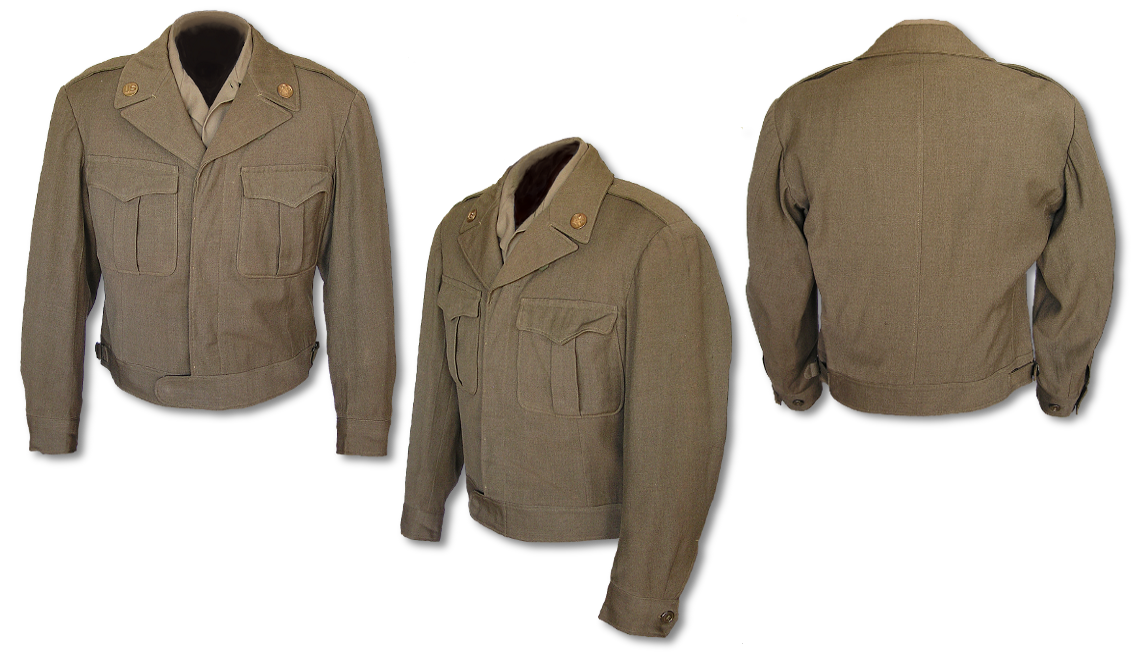
Specification PQD 437 Dated 12 May 1944
Stock No. 55-J-384-510 - 55-J-384-940
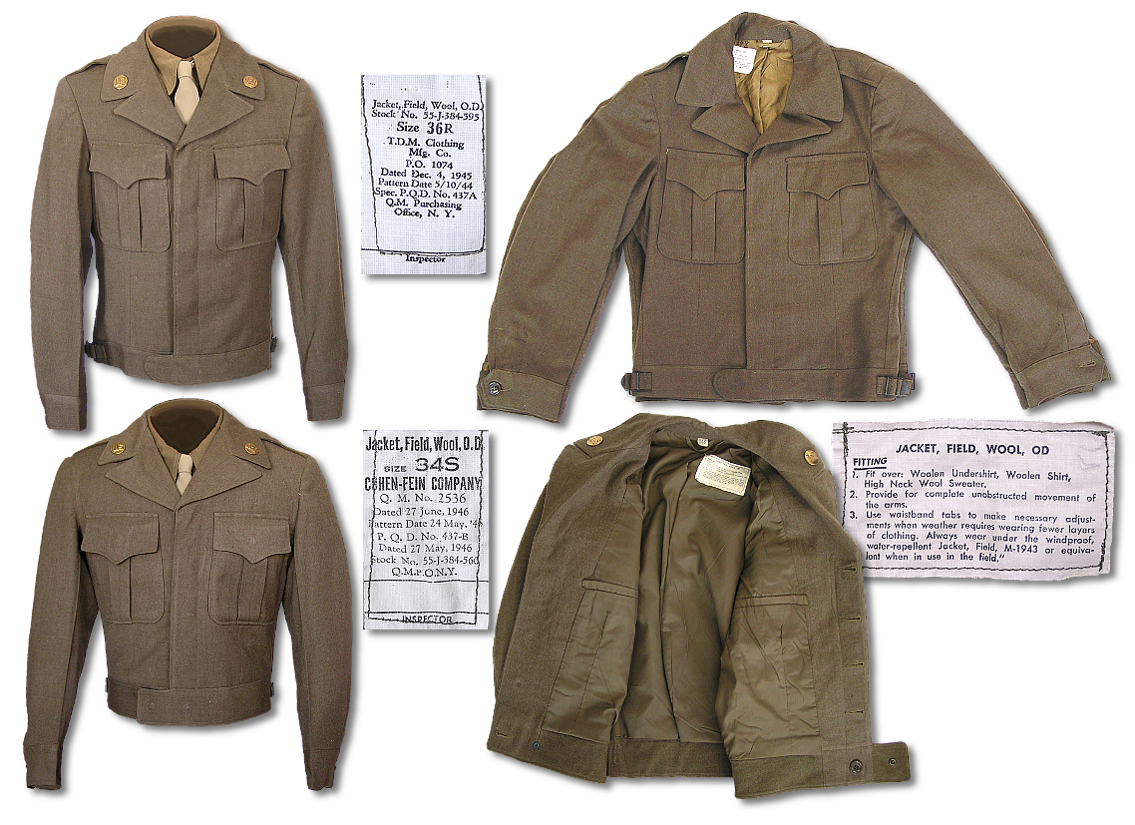
Above, Left: The Olive Drab Wool Field Jacket Spec. PQD 437A. This jacket was redesigned to be closer fitting in the body and sleeves. It also had a new bottom closure on the waistband and came with an instruction label explaining the proper use and fit of the jacket. Above, Middle: Contractor label for Spec. 437A. Above, Right: An example of Spec. 437A overlayed on 437, both in the same size, illustrating the slight reduction in body and arm width of the new pattern. Below, Left: The Olive Drab Wool Field Jacket Spec. PQD 437B. This jacket was again redesigned for a closer overall fit, had a new waistband design, and a synthetic lining. Below, Middle: Contractor label for Spec. 437B. Below, Right: The inside lining of Spec. 437B. Below, Far Right: The instruction label common to both 437A and 437B jackets.
Specifications PQD 437A Dated 2 June 1945 & 437B Dated 27 May 1946
(Table of Equipment No. 21, 1 September 1945)
| ORGANIZATION, UNITS, SPECIALISTS, & STATUSES | ZONE OF INTERIOR |
|
||||||||||||||||||||||||||||||
|
||||||||||||||||||||||||||||||||
| Key Visual ID | Primary Materials | Fasteners | Color | Labeling |
PQD 437:
| PQD 437 & 437A:
| All types: Buttons (14 total):
| All types:
| All Types: Size Label:
Instruction Label:
|
| Treatments | Est. Procurement Dates | Preceded By | Replaced By | Companion Garments |
| N/A | PQD 437:
| PQD 437:
| PQD 437:
| Field use:
|
(Touch Images for Expanded View)
|
The origins of the Olive Drab Wool Field Jacket, or "Ike Jacket" as it was fondly known, were rooted in the failures of both the wool service coat and olive drab field jacket to perform effectively in combat situations. Senior officers in the ETO European Theater of Operations - An abbreviation used to refer to the area in which US ground, sea, and air forces operated during WW2 that was north of Italy and the Mediterranean coast and generally included Britain, France, Germany, Austria, Belgium, Netherlands, Denmark, Czechoslovakia, and Norway. became convinced by example of the British Battle Dress that a similar outfit, featuring a short wool jacket made of thick, coarse wool, would be the most suitable for US troops campaigning in Europe. Despite the Army's recent shift in clothing doctrine that separated dress and combat items into distinctive categories, the ETO Command subscribed to the dual purpose uniform concept believing that a combination of combat effectiveness and smartness of appearance went hand in hand and was a critical factor in maintaining morale and discipline. The ETO Command's unshakable belief in this type of uniform was held firm until the wool jacket was finally authorized for production in early 1944, thus ensuring its place in the Army's new universal combat uniform. Though the Ike Jacket would become a popular and well recognized garment of the WW2 period, delays in its development, procurement, and delivery resulted in, for the most part, its being left out of combat on continental Europe. In the end, much time and effort went into the development of a garment that was unable to fulfill its intended purpose. In early 1940 the wool service coat underwent modifications to improve its utility in the field, including adding a bi-swing back for range of motion and larger pockets for increased carrying capacity. A year later, in early 1941, the first true field jacket known as the M-1941 model, featuring a wind and water repellent cotton shell and flannel lining, was approved for general issue and was to replace the wool coat in the field. Both of these garments, however, exhibited numerous shortcomings when subjected to strenuous field use during simulated combat and also during the North African Campaign. Complaints about these garments were numerous and included inadequate warmth, poor durability and utility, designs that too often restricted movement, and the difficulty of washing and maintaining them while in the field. By early 1943 these shortcomings left no doubt that an improved general issue combat uniform was urgently needed. A major difference of opinion existed between the senior command of the ETO and the OQMG Office Of The Quartermaster General - An abbreviation used to refer to the branch of the Army responsible for the development, procurement, and distribution of a wide variety of materials used by the Army including, but not limited to, sustenance, housing, and clothing. on what form a new combat uniform should take. The ETO Command advocated a wool outfit featuring a short jacket similar to the British Battle Dress type. This kind of uniform was desirable for a number of reasons: It could be used for both dress and field work because its dual purpose design offered adequate freedom of movement for exercise, while at the same time it was fitted closely enough to offer a smart appearance when worn for dress; it was made up in a heavy, coarse wool that was considered warmer than the type used in American uniforms; and it could be hand washed in the field without ruining its appearance. The OQMG, on the other hand, since 1940 had moved toward ending the use of dual purpose uniforms, and instead began designing new uniforms especially for field use. These new uniforms featured the latest wind and water resistant materials, designs with a much higher degree of combat utility, and involved an integrated layering system of woolens, pile fabrics, and cotton shells. This approach allowed versatility by allowing the soldier to function effectively in a variety of climates and conditions. In the period between 1940 and the end of 1942, the OQMG had developed a number of new generation combat uniforms tailored to the needs of specialized forces, such as parachute, mountain, and armored units. Eventually though, the introduction of too many new uniforms began putting considerable pressure on procurement and supply logistics. Thus, by the time the QMC's program got under way to improve the standard issue combat uniform in the fall of 1942, it became imperative that a universal outfit be developed that possessed the versatility to be worn by most troops, regardless of specialty, and under most weather conditions. This in turn would have the effect of significantly reducing the number of different field uniforms that needed to be supplied. With much at stake, the QMC prioritized the development of a new battle jacket and trousers, which would be part of a new "universal combat uniform". The program's development and testing process was to be pronounced and deliberate in order to reduce the chances of failure. In fact, the whole process took almost a year beginning in September, 1942 and culminating in August, 1943 when the M-1943 field jacket, the most crucial component of the new outfit, was eventually approved as a standard issue item. While the QMC's new field uniform was going through its lengthy development process the ETO Command, AAF, and Mediterranean Command, called for more immediate solutions to the shortcomings of the Army's current field uniform situation. These requests would, for the most part, be given lower priority in deference to the OQMG's universal combat uniform project. Multiple reports were submitted to the OQMG calling for the Winter Combat Uniform, used by armored crews, to be adopted as the standard issue combat uniform. In addition, the ETO Command made repeated requests that a battle dress similar to the British type be developed. The sense of urgency felt by the ETO command and later the AAF to improve existing field uniforms resulted in both of these entities initiating their own independent programs to develop suitable field garments.
In October, 1942 the ETO command first took independent action to develop a suitable battle uniform when General Sovervell, Chief of the Army Services of Supply, first authorized the purchase of wool uniforms by the ETO Quartermaster for testing purposes. Then, in December, General Eisenhower authorized the purchase of 300,000 wool jackets from suppliers in England. Due to numerous design changes, the first of these jackets (commonly known as ETO Jackets) wouldn't be delivered until May, 1943. The first version of the ETO jacket (Specification U/1180) was very similar in appearance to the early Olive Drab Field Jacket (Specification PQD 20 dated 24 January 1941), with the main differences being that the ETO jacket was made in wool, had a button instead of a zipper front, and made use of an adjustable belt and buckle arrangement at the front of the skirt. In July, 1943, the early ETO jackets were subjected to thorough testing by the 8th Air Force and 29th Division in England, and as a result major changes were made to the design. The new jacket (Spec. U/1379) bore a much stronger resemblance to the British 1940 pattern Battledress Blouse and was approved for issue in September, 1943. The new look of the ETO jacket involved eliminating the old style slash pockets in favor of patch pockets, which were now located on the upper breast for easier access, adjustable shirt style cuffs were used, and the belt and buckle front were eliminated in favor of hip adjustment tabs. In November, 1943, it was ordered that all remaining stocks of ETO jackets be issued to the 8th and 9th Air forces so that they could be utilized in combat missions. Procurement of ETO jackets was eventually halted in early 1944 as the development of the general issue wool jacket took shape.
In February, 1943 the Research & Development Branch of the Military Planning Division, OQMG conducted a clothing study on behalf of the Air Transport Command in which it was concluded that both the officer and enlisted men's wool service coats were ineffective garments for combat flying. Around the same time, the R&D Branch also began an analysis of the British Battle Dress outfit, which had been cited by ETO officials as having a particularly effective combination of characteristics allowing it to be used for both combat and dress wear. Analysis of the British uniform was positive overall, however changes were recommended, such as adding roominess for additional garments to be worn underneath, and the use of concealed buttons. Later, in May, 1943, the R&D Branch made a recommendation to the Air Transport Command and Army Service Forces that a short wool jacket be considered to replace the wool service coat and field jacket in combat areas. During that summer, the R&D Branch developed a number of experimental wool jacket samples, and in September they were sent along with patterns and specification drafts to the Army Air Force to be used as standards in the manufacture of such a jacket. Work was done on a new service jacket for the AAF that eventually resulted in the introduction of the Enlisted Man's Light Flying Jacket (B-14), which eventually became standardized on 14 March 1944. The B-14 jacket was a short, wool, dual purpose garment that could be used for both flying and general service wear. It was made in 18 ounce serge wool and had many new features that enhanced its combat serviceability, including concealed buttons to prevent snagging, adjustable shirt style cuffs for warmth and easy maintenance, shoulder loops, two slash pockets and two internally hung breast pockets, and waistband adjustment tabs that could be used to seal in warmth. By the spring of 1944 there were at least four well known projects in various stages of completion in response to the call for a more effective Army combat outfit. Among them were three short, dual-purpose, wool jackets, which included the AAF's new light flying jacket, the revised ETO field jacket, and the R&D Department's wool jacket samples. Of the four projects, the most important was the QMC's finalization of a new universal field uniform centered around the M-1943 Field Jacket. The M-43 jacket was constructed using an outer layer of wind and water resistant sateen and an inside layer of poplin. It was designed to be worn alone in moderate weather and over other garments, as a protective outer shell, in colder conditions. The layering system around which the new combat uniform was built had been advanced further and now included the addition of heavier pile liners that could be worn underneath the M-43 jacket and cotton trouser shells for use in very cold temperatures. At this point in the development of the new universal combat uniform, nowhere had consideration been made for the inclusion of a dual purpose wool jacket of the types recently developed. In fact, it could be argued that with the introduction of the new M-1943 combat uniform items, Army clothing doctrine had moved even farther away from the dual purpose uniform concept. The new M-1943 field jacket would be standardized on 12 August 1943. As it stood, the situation at the beginning of 1944 left two clearly delineated points of view on how US troops should be outfitted for combat on mainland Europe. On the one hand there was the ETO Command lobbying for a uniform similar to the British Battle Dress type, and leaving no doubt about its commitment to this concept as clearly demonstrated by its own development and local procurement of a similar uniform; and on the other hand there was the QMC's new combat uniform based on the layering principle. Out of necessity it would take the reconciliation of these two concepts, as well as many compromises in design details, before a general issue wool jacket would emerge. Several postwar OQMG historical studies cite a 1943 letter written by Gen. Eisenhower to Gen. Marshall as having great influence in propelling the development of the general issue wool field jacket forward. In this letter Eisenhower suggested that the OQMG develop a wool field uniform for US forces similar to the type used by the British. He also discussed the importance of a smart appearance and its positive effects on the morale and discipline of soldiers. In this regard he considered the British uniform far superior to the loose, baggy fit of the American field jacket and trouser combo. Although the exact date of this letter is unknown, it was forwarded to the OQMG by Gen. Marshall soon after he received it. Discussions and an evaluation of the British Battle Dress outfit soon followed and eventually led to the development of sample jacket patterns later in the summer of 1943. The weight of Eisenhower and Marshall's intervention on the matter of the wool jacket likely had significant impact in that at some point the project gained permanent traction despite the fact that the OQMG was primarily concerned with the development of the new universal combat uniform and otherwise would have had no interest in moving the project forward. In February, 1944 Capt. William F. Pounder, a Quartermaster Observer, brought the latest samples of the wool field jacket and M-1943 field jacket to the ETO for demonstration purposes. At the time, the Chief Quartermaster of the ETO, Gen. Robert M. Littlejohn, rejected the QM's wool jacket sample as being inferior to the locally procured ETO jacket. The wool jacket shown to Littlejohn was made up of 22 ounce serge wool, and could not be washed in the field - a quality considered essential for success. Also, Littlejohn expressed no interest in procuring the M-1943 field Jacket because adequate stockpiles of older clothing had already been built up while planning for the invasion of Europe. This stockpile included huge quantities of standard, limited standard, and substitute standard items, all of which had to be expended before new items could be ordered. Additionally, Gen. Littlejohn regarded many of the older issues on hand as superior to the new M-1943 design. Consequently, at the time Littlejohn still wanted to advance the development of the wool jacket, but no future orders for the M-1943 jacket were even considered. General Eisenhower once again intervened on behalf of the wool jacket when he cabled the War Department on 17 March 1944 requesting that an ETO type wool jacket be officially adopted for all troops in the European Theater of Operations. Eisenhower's continued push for the wool jacket is not at all surprising given the recent appearance of the M-1943 field jacket with its fully bloused cut that was hardly in line with his penchant for smart looking uniforms. Still convinced of the superiority of the wool field jacket, the ETO command rejected the M-1943 Field Jacket other than approving it for parachute troops. It was Littlejohn's intention to supply troops during the coming winter with the wool field jacket, sweaters, and wool overcoat. Any shortages were to be made up by the old M-1941 field jacket. At this same time, the revised requirements for the wool jacket was set at nearly 4.3 million units, of which 300,000 could be procured from British manufacturers. Shortly after Eisenhower's cable, Chief Quartermaster of the ETO, Gen. Littlejohn departed for Washington for pre-invasion conferences. During his time in Washington, Littlejohn planned to reconcile the differences between the OQMG's version of the wool jacket and his existing ETO design. In April, over a couple of days, these meetings took place and included Maj. Gen. Lucius D. Clay of the Army Service Forces, Col. Doriot of the Military Planning Division, OQMG, also present were clothing advisors to the OQMG and others. Discussions resulted in a new design that combined elements of both OQMG and ETO jackets. However, the majority of the concessions came from the ETO design, including having to forgo the coarse English wool that was the source of its warmth and durability and considered by its advocates as being crucial to its success. Instead, standard US 18 ounce wool serge was substituted; the same material used in the enlisted man's service coat, of which there was a ready supply available from US manufacturers. Additionally, the bi-swing back and half belt were eliminated in favor of a fully cut pattern that would allow freedom of movement with garments layered underneath; pleats would be added to the pockets to increase their carrying capacity; and the pocket and front closure buttons would now be concealed to prevent snagging. In May the final design was submitted to Army Service Forces Headquarters and to the ETO Quartermaster where it received final approval. The end result could perhaps best be described in visual terms as a hybrid of the second pattern ETO and AAF B-14 jackets.
On 12 May 1944, the Philadelphia Quartermaster Depot set the specifications (PQD 437) for the new jacket and it was given the nomenclature "Olive Drab Wool Field Jacket". The first contracts were let by the end of the month and were to continue unabated through the end of December, 1944. Early on it had been decided the wool jacket would take the place of the enlisted man's service coat in the ETO. Thus, the bulk of the early production of wool jackets was sent to class II supply depots in the ETO via NYPE New York Port Of Embarkation - An abbreviation used to refer to the Army command under the Transportation Corps responsible for the operation of port facilities through which the shipment of supplies and troops to overseas ports was arranged.. The wool jacket was also pegged to replace the OD Pile Field Jacket for wear underneath the M-1943 jacket in most cold weather situations. Official OQMG instruction stated that the M-1943 jacket should be worn alone in moderate weather and over the wool jacket in cold temperatures. Contrary to this, the ETO command, having forsaken the M-43 jacket, intended to use the wool jacket as the primary field garment with an additional wool overcoat worn as the outer garment in winter weather. The Olive Drab Wool Field Jacket was finally standardized on 2 November, 1944 becoming a general issue item wherein the enlisted man's wool service coat, which had not been procured after June, 1943, was re-classified as Any hope the wool jacket could be produced, shipped, and distributed to the ETO in time for the winter campaign of 1944-45 quickly began to unravel. On 20 April 1944, the ETO command was notified by the ASF command that production requirements for wool jackets would fall well short of estimates and that only about 2.6 million could be delivered by the end of 1944. As it turned out, the production process of the jacket was much more complicated than originally believed. To assemble the jacket required an inordinate amount of hand tailoring due to its complex features, which included a full lining, pleated pockets, and concealed buttons. Original production estimates had been mistakenly calculated on a simpler, machine made pattern. This would cause production to be significantly delayed until enough skilled manufacturers could be found, or plants retooled to produce the jacket. To help make up for projected shortfalls in the wool jacket, Gen. Littlejohn was offered 479,000 of the old style M-1941 olive drab field jackets. During the 17 April 1944 meeting in Washington, an official from the Storage and Distribution Division, OQMG had assured Gen. Littlejohn that there were adequate stocks of the old style olive drab field jackets available in the supply chain to meet the needs of troops in the ETO until the new wool jackets arrived. This would not hold out to be true. Procurement contracts for the M-1941 field jacket, like the enlisted man's wool coat, had essentially been halted by the end of June, 1943 so that industry could concentrate on producing the new M-1943 universal combat uniform items. Consequently, stocks of M-41 jackets were being depleted rapidly and were not being replenished. Nevertheless, at the beginning of May, 1944, Littlejohn requisitioned the 479,000 field jackets he had been offered earlier. Not surprisingly, on 17 May 1944 Littlejohn was notified by the Clothing & Equipage Branch, OQMG that there would not be sufficient stocks of the M-41 jacket to meet his request, and instead the new M-1943 would be sent to make up for any shortages. The situation that developed is not at all surprising given the true status that the M-1943 field jacket had achieved by this time. In August, 1943 it had been standardized, and in December of that year it appeared in the Table of Equipment for the first time. In the new table of equipment, the M43 was given worldwide issue status; after stocks of the old field jacket were exhausted it was to be issued across all temperature zones, with exception of the tropics. In reality this meant that the M43 would eventually be standard fare for troops in the ETO regardless of the how the commanders there felt about the matter. This was confirmed early in May, 1944 when the ETO command was notified by cable that the M43 jacket and high neck sweater combination was to replace the M41 jacket in all temperate climate zones and was eventually to become a requirement for all troops. Despite these developments, the ETO Command still showed no interest in ordering the M43 jacket because expectations remained centered on receiving the new wool jacket with any shortages thereof being made up by the M41 jacket. Then, as mentioned above the ETO command was informed there would, in fact, not be ample supplies of the M41 as promised, and to expect shortages to be filled with the new M43 jacket. Still opposed to the inevitable, Eisenhower cabled ASF on 1 June 1944 stating that the ETO would not need the M43 jacket except for parachute troops and that troops would be outfitted with the wool jacket, wool overcoat, and sweater combination for winter campaigning. This refusal to embrace the new M-1943 field uniform and order its components in a timely manner, would ultimately contribute to the shortage of adequate winter combat clothing in the ETO during the winter of 1944-45. It wasn't until September, 1944 that the first 500,000 wool field jackets were ready for shipment to the ETO. With winter fast approaching it was now clear that the wool field jacket would not serve as the basis for any type of winter uniform in the ETO. Accordingly, on 12 October 1944 457,751 arctic field jackets, 245,239 OD field jackets, and 797,020 wool service coats were shipped to the ETO to offset production shortages of the wool jacket. Production delays, shortages of cargo shipping, and port congestion would all conspire to hamper deliveries of the wool jacket. By the end of January, 1945 only about 1.3 million wool jackets had been delivered to the ETO - a figure well short of the original projected need of 4.2 million units. At this point commanders agreed not to issue the wool jacket en masse until after VE day in order to maintain uniformity of appearance among troops and ensure an orderly dissemination of the new uniform. However, some jackets had been authorized for issue, by way of a September, 1944 War Department Circular, to troops returning to the US from the ETO. But, in the end, virtually no wool jackets were issued to combat troops in Europe during the war, save for a small number that were issued for testing purposes to the Third Army - surely, a major disappointment considering the effort made to get the wool jacket approved. The story of the development of an improved field uniform for the troops in the ETO was essentially a failed one. Instead of being outfitted with an homogeneous uniform built around either the wool jacket or the M-1943 jacket, troops in the ETO were, for the most part, left with neither. Instead they had to get through the European winter of 1944-45 outfitted with a hodgepodge of uniforms that included the OD field jacket, arctic field jacket, ETO manufactured wool jacket, mackinaw coat, winter combat jacket, wool overcoat, as well as some quantities of the new M-1943 field jacket. Additionally, sometimes these issues were found to be less than adequate for conditions men faced, and sometimes they were in short supply. The concept behind the wool field jacket was fundamentally different than that of the service coat it was to replace. Though both were dual purpose garments, the jacket was designed to function primarily as a field garment rather than a dress garment. This resulted in a jacket with a radically different look and many updated design features crucial for success in the field.
Of the jacket's many new features, perhaps the most crucial was its ability to be readily maintained in the field. Unlike the old service coat, the new jacket could be hand washed and dried without losing its form. This was made possible by the use of a new type of padding material in the shoulder area that was able to remain resilient when subjected to washing. The use of shirt style cuffs was another feature that helped with field maintenance. Using this type of cuff allowed salvage shops to easily replace them when fraying or other damaged occurred. The jacket also avoided the use of a zipper, a characteristic of the M-1941 field jacket, which proved prone to breakage and was difficult to repair in the field.
The short length of the jacket facilitated bending and squatting, and allowed it to be worn underneath a number of jackets, coats, and parkas during cold and/or wet weather. The jacket was also cut large so that a number of layers of clothing could be worn underneath it for warmth while at the same time not restricting arm movement. These dimensions were essential in allowing the jacket to be incorporated into the new universal winter combat uniform. Body temperature was easily regulated through the use of slide adjusters on each side of the waist band, two-position button adjustments on the cuffs, and a closure tab underneath the left lapel that allowed the collar to close around the throat. Under the 18 ounce serge wool exterior, the jacket had a full cotton lining, which provided additional comfort and warmth. Every aspect of the jacket had been designed to provide utility in the field. The front closure and pocket buttons were concealed to prevent them snagging on equipment and terrain. The two front breast pockets were large and constructed using expansion pleats for increased carrying capacity. Since the length of the jacket limited it to two outside pockets, two additional pockets were added to the inside, which furthered its carrying capacity. Intelligence debriefings of men returning to Camp Lee from the Mediterranean Theater revealed that the wool field jacket was not being worn as intended. Instead of using the jacket as a field garment, it was kept in the rear and only used during dress occasions, as had been the practice with the old service coat. Quartermaster officials from the Research and Development Branch visited the ETO in the summer of 1945 to make observations and essentially found the same practices in place that had been reported by men returning from the Mediterranean. In addition to the fact that men tended to set the wool field jacket aside for dress wear, they also noticed the wool jacket was being issued in sizes smaller than recommended. The jacket, like other articles in the universal combat uniform system, was cut to a pattern that was looser than the size stated on the tag so as to accommodate layers of clothing underneath. Soldiers, on the other hand, viewing the jacket as a dress garment, desired a close fit of the type traditionally found in smart looking military uniforms. To achieve this look, soldiers were receiving jackets tagged in sizes smaller than what they would normally wear thus negating a significant aspect of the garments combat effectiveness. Additionally, some jackets were being tailored in at the waist. This practice left the adjustment straps redundant, which were then sometimes removed, further reducing the functionality of the jacket. There was enough concern raised by the Quartermaster's observations that action was taken to remedy the situation. Special instruction was given to personnel at issuing stations and depots on the proper fitting procedure for the jacket. In addition to this, changes were made to the jacket itself. First, a handy instruction label was added to the inside of the jacket explaining how the jacket was to be properly fitted and used. |
Second, the pattern of the jacket was altered by slightly decreasing the width of the chest, body, and sleeves, while at the same time increasing the ease of the sleeves. These changes effectively reduced the bagginess of the jacket while still allowing the required garments to fit underneath. And lastly, the bottom closure of the waistband was redesigned in order to make it easier to close and remain secured around the waist. This involved moving the bottom button to the button hole side of the jacket and the button hole to the button side of the jacket, essentially creating a retaining button similar to the type used on double breasted garments.
Specifications for the new design were drawn up on 2 June 1945 and designated PQD 437A. Procurement commenced on 27 July 1945. As designed, the new jacket appeared less baggy than its predecessor, although it was not nearly as close fitting as the improperly sized and tailored down jackets that troops were already wearing. The instruction label, large and conspicuous, was located in the nape of the neck and stated in regards to the jacket's proper fitting: "As a component of the field uniform it should always be fitted over the undershirt, wool 50-50, the shirt, flannel, od, and the sweater, highneck." The wool field jacket was further modified in the spring of 1946. A synthetic lining was adopted that assisted in easement and comfort, and was similar to the type used in the officer's jacket. Changeover to the new lining was slow and production continued on with the Silesia lining until the material was used up. Changes were also made to the waist area. The jacket was made shorter and the waistband was made wider and fitted closer to the waist. The waistband closure tab was also redesigned to be squared at the end instead of rounded. Specifications were drawn up at the Philadelphia Quartermaster Depot on 27 May 1946 and designated 437B. Contracts were issued during the forthcoming June. By this stage of development much the sloppiness of the early OD wool field jacket had been cleaned up. But, the end was near as this jacket was among the last of its type to be classified as a field garment. In the long run, the effort to educate troops in the proper use and fitting of the olive drab wool field jacket failed. The demand amongst troops for a smart looking dress uniform was just too great. There was likely a number of factors contributing to this: a well established culture already existed that was use to the tailored 4-pocket wool service coat; when the war ended in Europe in May, 1945 there was no pressing need to use the wool jacket as a field garment; the practice cutting down the 4-pocket coat to mimic the ETO and "Ike" jackets only helped reinforced that jacket should be tight fitting; with the war over there was a return to the "spit-and-shine" culture that existed beforehand. The Ike jacket was well-liked and was produced for several years, but it is no real surprise that it failed as a successful dual-purpose field/dress garment. A similar fate befell the jacket's predecessor, the enlisted man's service coat. After evolving into more or less a dress garment during the 20's and 30's, in 1940 the Quartermaster re-introduced features into the coat to improve its field utility. However, this attempt was too little and too late as the coat had become far too feeble to be an effective field garment on the modern battlefield. Just the opposite, the wool field jacket, possessing superior field characteristics, didn't make a good dress uniform. The fact of the matter was that the design requirements for a dress uniform and those of a field garment were naturally at odds, and when combined make for a uniform that isn't particularly adept at either role. The final chapter in the dual-purpose uniform was, however, shortly to come. The year 1950 finally saw the end of the dual-purpose wool jacket. That year the jacket was re-designed to function solely as a component of the service uniform. To facilitate this transformation, the design of the M-1943 field jacket also had to be revised since the wool jacket was used as a liner underneath it in cold weather. This was accomplished by introducing a button-in liner for the M-1943 jacket, which was then re-designated "M-1950 Field Jacket". The new wool jacket was renamed "M-1950 OD Wool Jacket" and would remain essentially the same until the late-fifties when the four-pocket service coat was updated and re-introduced.
Although the overall appearance of the M-1950 wool jacket was similar to the old one, in fact, many changes were implemented to produce the new design. Most all of the features in the old design that made it a useful field garment were removed. This included doing away with the shirt-style cuffs in favor of straight sleeves, removing the throat closure tab, and removing the adjustable buckle waist straps for a simple one-button affair. Additionally, one inner pocket was removed and the front pockets were changed from an expandable pleat to a non-expandable type. Other modifications were made to the jacket to tidy its appearance for dress wear including further reducing the overall proportions for a closer fit, adding shaping pleats around the waist, and replacing the front pocket buttons with a pair of small ball and socket snaps located on the corner of each flap.
Since the wool jackets was authorized to replace the wool coat for overseas use in temperate and cold climate zones, initial production was directed mostly toward troops serving in the ETO, Mediterranean, and North African Theaters of Operation. The first shipments of the jacket weren't ready until September, 1944 and were sent to class II depots in Europe. Because of delays and slow delivery, the jacket wasn't issued en masse until after VE Day. Prior to this only a small number were issued to units of the Third Army for test purposes and effective 30 September 1944 the wool jacket was authorized for issue in lieu of the service coat to men returning to the US from Europe. Once industry had been converted to producing the wool jacket, and there was ample quantity in the supply lines, the jacket was more widely distributed. It would eventually become standard issue for all Army and Army Air Force enlisted men. The table of equipment published 1 September 1945 lists the wool jacket as a mandatory issue for enlisted men in both the zone of interior and in theater of operations and in all climate zones except tropical. Each enlisted man received one jacket as part of his mandatory clothing and equipment allowance and as such it was free of charge. Enlisted men were expected to keep the coat clean and take care of any minor repairs that needed to be done during their time in service. Jackets were to be issued according to chest size and length. Chest tariffs ranged from 32 to 50 and lengths were cut in four sizes; regular, short, long, and extra long. Once a soldier was matched with a jacket of his corresponding chest size and length, it was intended that there be adequate room left over to accommodate the additional layers of clothing that were meant to go underneath. Unlike the previous wool service coat, the jacket was not intended to be altered or fitted because doing so could potentially hamper its ability to function as intended. Though strongly associated with the enlisted man, the original issue OD wool field jacket was, in fact, a universal field garment that was worn by both officers and enlisted men. The OD field jacket was listed in the Army's September, 1945 Table of Equipment as a mandatory purchase for officers when serving in theater of operations, with the standard service coat being allowed as a substitute. Though many officers continued to wear their dark shade service coats or had them cut down to the "Ike" style, some officers did utilize the jacket for its intended purpose. An officer's version of the OD wool field jacket, though relatively short lived, was procured between November, 1944 and August, 1945. It differed from the standard jacket by having a rayon lining instead of a cotton one, it had a label on the inside indicating it was for an officer, but other than that the two were indistinguishable. By the end of February, 1945 385,000 wool jackets had been transferred to sales stores in the ETO for sales to officers. In the summer of 1946, when the standard wool field jacket was updated with its own synthetic lining (see Specification 437B above), the officer's type was discontinued. With both jackets essentially the same, remaining stocks were intermingled and issued indiscriminately. For this reason enlisted men's insignia can be found attached to jackets bearing the officer's contract label.
Enlisted men were permitted to keep what amounted to one complete winter service uniform and one complete summer uniform at the time of their separation. For the men who had been issued the wool field jacket, this garment was to be included as part of the winter service uniform that they were allowed to keep. Officers, having purchased their jackets, were allowed to retain possession of this garment upon their separation from service. Before final departure from the separation center, a final accounting took place to determine the awards that each soldier was entitled to. After completion of this process, the various insignia were often applied to the garment along with a required honorable discharge emblem.
Army regulations stipulated that men receiving an honorable discharge should have a special emblem affixed to jackets, coats, overcoats, and shirts to indicate their status. This emblem, popularly known as the "ruptured duck", was a small lozenge patch depicting an eagle in gold, wings spread, standing amid a ring of thirteen stripes. The background was set in either olive drab or khaki material so as to match the colors used in the winter or summer uniforms. The emblem was sewn or sometimes even glued above to right breast area of the specified garments during the separation process. Once displayed, it provided an easy way to identify that the person wearing the uniform was discharged from service and had served their country honestly and faithfully. In addition, it afforded individuals the right to wear the uniform for up to thirty days after receiving their discharge.
Much variation existed in WW2 era garments due to differences in fabric shades, the use of alternative construction methods, and the use of substitute materials. While these characteristics did appear in the wool field jacket, they generally occurred with less frequency in comparison to other uniforms of the era. Achieving color uniformity in fabrics to the degree they are suitable for military use was a difficult enough task for the Quartermaster during peace-time. In war-time this challenge became exacerbated further when, in order to meet vast production schedules, it was necessary to purchase fabrics from a larger pool of manufacturers. Production methods and techniques of the time resulted in fabric shades that varied in color from manufacturer to manufacturer and even between different rolls of fabric produced by the same contractor. Furthermore, only a percentage of materials produced could be inspected for standards compliance. And it was also during war-time that standards were often purposely loosened in order to avoid rejection of materials that were already in short supply. It was also common to loosen quality standards to encourage more manufacturers to participate in military production. War-time production pressures and the need to conserve certain materials for use in more crucial projects also caused the use of substitute standard or alternative fabrics in the production of uniforms during the WW2 era.
Three main types of linings were used in the construction of the wool field jacket. Two different color cotton types were produced during WW2, and in 1946 a rayon type appeared with specification PQD 437B. Of the two cotton liners, the first type was light olive drab in color and was similar in appearance to the kind used in wool service coats and overcoats, but made in a lighter weight material. The latter type was produced in a darker shade that better matched the olive drab shade 33 wool material used on the exterior of the jacket. The two cotton linings were used intermittently throughout the war years after which the darker type became predominant during the post-war era. The rayon liner was introduced in the summer of 1946 and put the jacket on par with the regulation officer's version of the jacket. Soon after, further production of the officer's jacket was cancelled.
During WW2 the Quartermaster allowed contractors to employ various finishing techniques to clothing that were suited to the capabilities of their equipment and/or production processes. This allowed more manufacturers to participate in government contracts and helped the QM overcome large production problems. These practices resulted in the appearance of many small variances among the same type of garments. One such variation found in the wool field jacket concerns how the end of the pull tab for the waist adjustment buckle was finished. One type can be found squared off and hemmed over, while others were formed into a point. These two adjustment strap styles appeared intermittently throughout the life of the jacket.
Since the wool jacket was also used as a dress uniform, many can be found adorned with insignia. Insignia was attached to the upper portion of the jacket including the collar and lapels, above the upper pockets, on the pocket flaps, and on the length of both sleeves from the shoulder to just above the cuffs. The most common types of insignia were either sewn on in the form of unit, rank, and specialty patches; or pinned on in the form of medals, ribbons, badges, and crests. Some uniforms are seen with only the required minimum insignia present, while others are seen replete with insignia. It was also common for veterans to remove all or much of the insignia from their uniforms after the war leaving only shadow impressions of where they were once attached. Many uniforms are found in this condition. This was done for any number of reasons, but was commonly done to re-apply the insignia to veterans' association uniforms, or simply to make displaying them easier and more convenient. Some of the most common insignia found on the enlisted man's winter service uniform are highlighted below:
The introduction of the Ike jacket struck a resonate chord with troops during WW2. The short jacket with its stylish, new look was radically different than the long-time service coat and proved to be extremely popular. As troops awaited issue of the new uniform, some had their existing service coats tailored into the stylish new ETO design. This practice became fairly common and played an important part in the stories of both the service coat and wool field jacket. Many of these conversions survive today and are a testament to the frequency that these alterations occurred.
The quality of Ike conversions varied greatly. When compared to a wool jacket, some conversions captured minute details and appeared almost indistinguishable from an original, while many others only managed a vague outward resemblance. An easy way to spot an altered enlisted man's coat is to check for a partial lining - this was a unique feature of the coat, whereas the jacket had a full lining. The short jacket style was so infectious, in fact, that in addition to service coats many other types of garments were sent to the tailors to get this popular make-over. Some examples of these other garments include the M-1943 field jacket, herringbone twill jacket, and even cotton and wool shirts!
The practice of altering the wool field jacket to neaten its appearance became widespread in the post-war years. World War 2 and post-war era jackets can show any number of modifications including:
Some jackets showed only slight modification while others were heavily modified and often had several of the above mentioned alterations performed on them. When acquiring an Ike jacket, it should be inspected carefully for these and other alterations. Such alterations could potentially have a significant impact if the intent is to wear the jacket, or it is to be fitted to a mannequin, or it is sought specifically for originality of manufacture.
World War 2 era garments, for the most part, were made with fabrics composed of natural fibers. These fibers, and particularly wool, are a source of sustenance for a variety of vermin. This fact makes many WW2 era garments, such as the wool field jacket, vulnerable to damage when they are improperly stored. Damage can occur to localized areas or throughout a garment and typically appears as a series of small holes where the material has been eaten through, or can sometimes appear as depressions and tracks where the nap of thicker wool has been eaten down. This type of damage can easily ruin a garment, especially if it occurs on a focal point. There are many common types of pests that can make a meal out of a wool garment, such as clothes moths, roaches, silverfish, carpet beetles, and even mice. Therefore, it is imperative that garments made with natural fibers be stored in a safe area away from any potentially harmful pests. Garments should also be kept clean and free of excessive body perspiration and food stains as dirty garments provide an even stronger attraction to hungry pests. Throughout much of the Pacific War, many GI's and Marines stationed in Australia were issued a short wool jacket of a design specific to the Pacific Theater of Operations. This jacket along with similar types made and issued in the ETO helped pave the way for the mass acceptance and popularity of the later olive drab wool field jacket. These in-theater jackets and the Army's adoption of the style for general issue in 1944 eventually lead the Marine Corps adopting their own specific version of the "Ike" jacket. First, in 1945 a short style of jacket was authorized for USMC officers, and then later, in 1946, a short jacket became standard issue for USMC enlisted men. Finally, when the newly formed Air Force developed its new blue 84 uniforms in 1949, the short style jacket was retained as part of their new look. Spawned in war-time as a field garment, the wool jacket went through many changes, another war, and finally the Army's long overdue separation of field and dress garments to eventually log a service record of approximately 12 years. The jacket was very much liked by troops who wore it and was considered more modern and stylish than the previously issued service coat, which dated back to 1926. Its popularity among war-time troops spilled over into civilian life where similar styles were adopted as work uniforms for all types of occupations ranging from police departments to bus drivers. Despite a rocky start the "Ike" jacket eventually became one of the most recognizable uniform components associated with the WW2 GI. |







